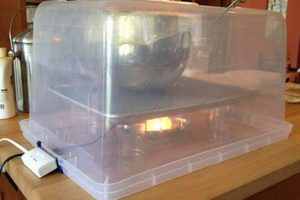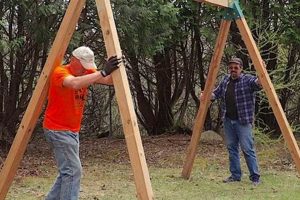A self-assembled system designed to enhance the structural integrity of temporary or semi-permanent shelters, such as tarpaulins or tents, against adverse weather conditions. It typically involves employing ropes or webbing configured to distribute wind loads more evenly across the shelter, reducing stress on individual attachment points. An example of this might involve creating a network of ropes extending from the shelter’s corners and center points, anchoring them securely to the ground at a distance.
Employing such a system offers several advantages. It provides increased resilience during high winds, potentially preventing damage or collapse. This can be critical in emergency situations or remote outdoor settings where shelter integrity is paramount. Historically, similar techniques have been used by mariners and outdoors enthusiasts to secure structures against storms, reflecting a longstanding need to mitigate wind-related risks.
The effectiveness of a user-created shelter reinforcement system hinges on several factors, including material selection, knotting techniques, and anchoring methods. Subsequent sections will delve into these aspects, providing guidance on constructing a robust and reliable setup.
Essential Considerations for Constructing a Wind-Resistant Shelter System
The following guidelines provide key recommendations for building a reliable system for reinforcing a temporary shelter against wind damage.
Tip 1: Material Selection: Utilize high-strength ropes or webbing, preferably those with low elongation characteristics. Polypropylene ropes are generally discouraged due to their lower strength and susceptibility to UV degradation. Polyester or nylon ropes offer improved durability and resistance to abrasion.
Tip 2: Knotting Techniques: Employ secure and reliable knots, such as the bowline, taught-line hitch, and square knot (reef knot), ensuring they are properly dressed and set. Avoid complex knots that may weaken the rope’s tensile strength or prove difficult to untie under tension.
Tip 3: Anchor Point Security: Select anchor points that are capable of withstanding significant pull-out forces. Large trees, sturdy rocks, or properly installed ground anchors are suitable choices. Ensure that the anchor point is free from sharp edges that could abrade the rope.
Tip 4: Load Distribution: Distribute the wind load evenly across the shelter by attaching ropes to multiple points, including corners, edges, and center points. This prevents excessive stress on any single attachment, minimizing the risk of tearing or failure.
Tip 5: Tensioning and Adjustment: Employ tensioning mechanisms, such as taut-line hitches or rope tensioners, to properly tension the ropes. This ensures that the system is effective in resisting wind forces. Regularly inspect and adjust the tension as needed, particularly during prolonged periods of high wind.
Tip 6: Ground Anchor Placement: When using ground anchors, position them at an angle that opposes the expected wind direction. This maximizes their holding power and prevents them from being pulled straight out of the ground. Consider using multiple ground anchors per rope for added security.
Tip 7: Regular Inspection: Conduct routine inspections of the entire system, paying close attention to ropes, knots, and anchor points. Replace any damaged or worn components immediately. Address any signs of loosening or slippage promptly.
By adhering to these guidelines, one can significantly enhance the wind resistance of temporary shelters, ensuring greater safety and security in adverse weather conditions.
The succeeding section will address advanced techniques and considerations for specialized shelter reinforcement scenarios.
1. Material Strength
Material strength constitutes a foundational element in the design and implementation of a self-assembled shelter reinforcement system. The ability of the system to withstand wind-induced stresses and maintain structural integrity is directly proportional to the tensile strength and durability of the materials employed.
- Tensile Strength and Load Bearing
Tensile strength refers to the maximum stress a material can withstand while being stretched or pulled before breaking. In the context of a self-assembled shelter reinforcement, ropes and webbing must possess sufficient tensile strength to bear the dynamic loads imposed by wind gusts. For example, a rope with a low tensile strength might fail under high wind conditions, resulting in the collapse of the shelter. Selecting materials with appropriately high tensile strength ratings is therefore crucial.
- Abrasion Resistance and Environmental Degradation
Shelter reinforcement systems are often exposed to harsh environmental conditions, including abrasion from contact with the ground, shelter fabric, or surrounding objects, as well as degradation from UV radiation, moisture, and temperature fluctuations. Materials with superior abrasion resistance and resistance to environmental degradation, such as polyester or nylon, will maintain their strength and performance over a longer period compared to materials like polypropylene which degrade quickly in sunlight. This prolonged functionality is essential for reliable protection during extended periods of adverse weather.
- Elongation Under Load and System Stability
The degree to which a material stretches under load, known as elongation, also impacts the effectiveness of a shelter reinforcement system. Excessive elongation can lead to slack in the system, reducing its ability to counteract wind forces and potentially destabilizing the shelter. Low-stretch materials, such as those made from high-performance fibers, minimize elongation under load, ensuring a more stable and responsive system. For instance, a rope with minimal elongation will maintain tension and effectively distribute wind loads, preventing the shelter from shifting or collapsing.
- Material Weight and Portability
While high strength is paramount, the weight of the material must also be considered, particularly for portable applications. Lighter materials are easier to transport and handle, facilitating rapid deployment in emergency situations or remote locations. Balancing strength requirements with weight considerations is essential for optimizing the practicality and usability of a self-assembled shelter reinforcement system.
The interplay between tensile strength, abrasion resistance, elongation characteristics, and weight dictates the overall performance and reliability of a shelter reinforcement system. Proper material selection, informed by a thorough understanding of these properties, is critical for ensuring the system’s effectiveness in protecting against wind damage and maintaining shelter integrity.
2. Knot Security
The effectiveness of a self-assembled wind-load mitigation system is fundamentally dependent on the integrity of its constituent knots. Knot security, defined as a knot’s ability to maintain its form and holding power under load, directly impacts the overall stability and resilience of the structure against adverse weather conditions. A knot failure within the system compromises its ability to distribute wind forces evenly, leading to potential damage or complete structural collapse. A properly tied and dressed knot, such as a bowline, will maintain its form and holding power even under significant strain, thereby contributing to the system’s overall robustness. Conversely, an improperly tied or selected knot, such as a poorly executed square knot, is prone to slippage or unraveling, severely weakening the entire configuration.
Real-world applications of self-assembled shelter reinforcement systems demonstrate the practical significance of knot security. Consider an emergency scenario where a temporary shelter is erected following a natural disaster. If the system securing the shelter relies on inadequately tied knots, a sudden increase in wind speed could lead to their failure, rendering the shelter vulnerable and potentially exposing occupants to the elements. Conversely, a system utilizing secure and properly executed knots provides a reliable safeguard, ensuring the shelter’s stability and protecting its occupants. Furthermore, the choice of knot is crucial; while some knots are known for their strength, others offer ease of tying or untying, which can be vital in rapidly changing weather conditions. A Taut-line hitch, for instance, allows for adjustments to rope tension as the shelter fabric stretches or the ground shifts, maintaining optimal security over time.
In summary, knot security represents a critical, often overlooked, element within the design and construction of a self-assembled wind-load mitigation system. The selection of appropriate knots, coupled with meticulous tying techniques, directly influences the system’s ability to withstand wind forces and maintain structural integrity. While the challenges associated with mastering various knotting techniques and selecting the optimal knot for each application are significant, the potential consequences of knot failure underscore the paramount importance of prioritizing knot security in all such endeavors. Ignoring this fundamental aspect can negate the benefits of even the most robust materials and anchoring systems.
3. Anchor Stability
Anchor stability is a critical determinant of the performance of any self-assembled storm bridle system. The primary function of a storm bridle is to distribute wind loads across the structure it supports, and this distribution is only effective if the anchor points themselves remain fixed and secure. Insufficient anchor stability undermines the entire system, concentrating stress on other components and potentially leading to catastrophic failure. For instance, a lightweight tent reliant on ground stakes in loose soil, even with a well-designed storm bridle, is vulnerable because the stakes can pull out under sustained wind pressure. This highlights a fundamental cause-and-effect relationship: inadequate anchor stability negates the benefits of a robust storm bridle design.
The importance of anchor stability is further illustrated by considering diverse environmental conditions. In rocky terrain, securing ropes around large boulders may provide adequate stability; however, in sandy or marshy areas, specialized ground anchors, such as auger-style anchors or duckbill anchors, are necessary to achieve comparable resistance to pull-out forces. Furthermore, the angle at which the anchor is placed relative to the direction of pull significantly affects its holding power. Driving an anchor perpendicular to the ground surface is often less effective than angling it to align with the anticipated direction of force. Practical application demands that individuals assess the specific site conditions and select appropriate anchoring methods to ensure the system’s integrity. A real-world example is the use of screw anchors in securing communication towers; these anchors are designed to withstand extreme wind loads by penetrating deeply into the earth, showcasing how appropriate anchor selection directly correlates to structure stability.
In conclusion, anchor stability is an indispensable component of an effective self-assembled storm bridle. It represents a critical link in the chain of components necessary for a reliable system. Challenges arise from variations in ground conditions and the need to match anchor selection to the anticipated wind loads. Understanding the principles of soil mechanics and anchor design is essential for maximizing anchor stability and, consequently, the overall performance of the storm bridle. Prioritizing anchor stability is paramount to safeguarding structures against wind damage and ensuring the safety of occupants during severe weather events.
4. Load Distribution
Load distribution, in the context of self-assembled wind-load mitigation systems, refers to the strategic allocation of wind forces across multiple points of attachment to minimize stress concentration and prevent structural failure. A system’s efficacy is contingent upon its ability to evenly disperse the forces exerted by wind, thereby reducing the risk of localized damage and enhancing overall stability.
- Even Force Allocation
Even force allocation is paramount to preventing any single point on the shelter from bearing the brunt of the wind load. This involves creating a network of ropes or webbing that distributes the force across the shelter’s surface. For example, if a large gust of wind pushes against one side of a tent, a well-designed system will transfer a portion of that force to the other side and down to the anchor points, rather than allowing it to concentrate on the windward side. This reduces the risk of tearing or collapse.
- Multiple Attachment Points
Employing multiple attachment points is essential for effective load distribution. The greater the number of points connecting the storm bridle to the shelter and to the ground anchors, the more evenly the wind load can be distributed. These attachment points should be strategically placed to cover the critical areas of the structure, such as corners, seams, and areas exposed to direct wind pressure. This approach minimizes the potential for localized stress and increases the overall resilience of the shelter.
- System Redundancy
Incorporating redundancy into the system provides a safety margin in case of a failure at any single point. This can be achieved by using multiple ropes or webbing sections, each capable of bearing a portion of the load. If one section fails, the remaining sections can continue to distribute the wind load, preventing complete system collapse. Such redundancy is particularly critical in situations where the consequences of shelter failure could be severe.
- Dynamic Adjustment
A well-designed system also allows for dynamic adjustment to accommodate changing wind conditions. As the wind shifts in direction or intensity, the tension in the ropes or webbing may need to be adjusted to maintain even load distribution. This can be achieved through the use of adjustable knots or tensioning devices, allowing the system to adapt to varying wind forces and preve
nt overstressing any particular point.
Collectively, these facets underscore the importance of load distribution in a self-assembled wind-load mitigation system. By ensuring even force allocation, employing multiple attachment points, incorporating system redundancy, and allowing for dynamic adjustment, one can significantly enhance the stability and resilience of the shelter against adverse weather conditions. Understanding these principles is paramount for designing and implementing an effective system.
5. Tension Management
Tension management is intrinsic to the efficacy of a user-constructed wind-load mitigation system. It dictates the degree to which the system can effectively counteract wind forces and maintain structural integrity. Proper tensioning ensures that the network of ropes or webbing acts as a cohesive unit, distributing loads evenly and preventing slack, which can lead to shock loading and potential failure. Insufficient tension renders the system largely ineffective, while excessive tension can overstress components, exceeding their working load limits and increasing the risk of breakage. For example, a storm bridle secured with ropes but lacking adequate tension will allow a tent to billow and sway excessively, subjecting the fabric and poles to increased stress, thereby negating the intended protective function.
Real-world applications underscore the importance of meticulous tension management. Consider the case of securing a temporary shelter in a windy mountain environment. Utilizing adjustable knots such as the taut-line hitch or incorporating mechanical tensioners allows for fine-tuning the system to accommodate changing wind conditions and material stretch. As the shelter fabric stretches under sustained wind pressure, the tension in the ropes can be adjusted to maintain optimal performance. Conversely, if a sudden lull in the wind occurs, reducing the tension prevents overstressing the anchor points. Observing professional applications, one notes that engineers constructing temporary structures employ calibrated tensioning devices to ensure precise load distribution and structural stability, emphasizing the critical nature of controlled tensioning.
In summary, tension management is a cornerstone of a functional storm bridle, representing a vital element in its overall performance. Challenges stem from the need for dynamic adjustment in response to fluctuating environmental conditions and the potential for overstressing components. A comprehensive understanding of material properties, knotting techniques, and tensioning mechanisms is essential for effective implementation. Mastering these aspects maximizes the system’s ability to safeguard structures against wind damage, ensuring the safety and security of occupants. Neglecting tension management renders even the most robust materials and anchoring systems largely ineffectual.
Frequently Asked Questions
The following questions address common concerns and misconceptions regarding the construction and deployment of user-created systems for enhancing shelter resilience against wind damage. These systems aim to provide a cost-effective alternative to commercially available solutions.
Question 1: Is a user-created shelter reinforcement as effective as a professionally engineered solution?
The effectiveness of a user-constructed system depends heavily on the builder’s knowledge, skill, and adherence to sound engineering principles. While a professionally engineered solution offers a higher degree of certainty due to rigorous testing and quality control, a carefully designed and executed self-assembled system can provide a substantial improvement in shelter stability.
Question 2: What are the most common points of failure in a self-assembled shelter reinforcement system?
Common failure points include inadequate anchor stability, insufficient material strength, improperly tied knots, and uneven load distribution. Addressing these areas during design and construction is crucial for ensuring system reliability.
Question 3: Can any type of rope or webbing be used for constructing a storm bridle?
No. The selection of appropriate materials is paramount. High-strength, low-elongation ropes or webbing, such as those made from polyester or nylon, are recommended. Polypropylene ropes are generally unsuitable due to their lower strength and susceptibility to UV degradation.
Question 4: How does one determine the appropriate number of anchor points for a given shelter?
The number of anchor points depends on the size and shape of the shelter, as well as the anticipated wind conditions. As a general guideline, more anchor points are preferable, particularly for larger shelters or those exposed to high winds. Even load distribution across multiple points is more important than the overall number of anchor points.
Question 5: How often should a self-assembled shelter reinforcement system be inspected?
Regular inspections are essential, particularly during prolonged periods of adverse weather. Ropes, knots, and anchor points should be inspected for signs of wear, damage, or loosening. Any compromised components should be replaced immediately.
Question 6: Is specialized knowledge or training required to construct a reliable storm bridle?
While specialized engineering knowledge is not strictly necessary, a thorough understanding of basic knotting techniques, material properties, and anchoring principles is highly recommended. Consulting with experienced outdoors enthusiasts or seeking guidance from online resources can be beneficial.
In summary, user-created shelter reinforcement systems offer a viable means of enhancing shelter resilience. However, success hinges on careful design, proper material selection, sound construction practices, and regular maintenance. Prioritizing safety and adhering to established guidelines is paramount.
The subsequent section will delve into advanced techniques and considerations for specialized shelter reinforcement scenarios.
DIY Storm Bridle
This exploration has illuminated the multifaceted aspects of the self-assembled wind-load mitigation system. Critical elements, including material strength, knot security, anchor stability, load distribution, and tension management, were examined to underscore their importance in ensuring structural integrity during adverse weather conditions. While not a replacement for professional engineering, a competently constructed diy storm bridle can offer significant protection for temporary shelters.
The diligent application of the principles outlined herein is encouraged for those seeking to enhance the resilience of their shelters against wind damage. Prioritizing thorough planning, meticulous execution, and ongoing maintenance will maximize the effectiveness of such systems. The security and safety afforded by a well-executed storm bridle warrant the commitment and rigor required for its proper implementation.







